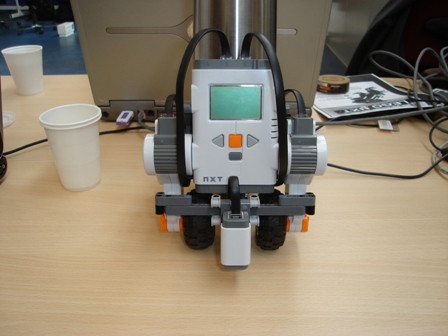This is an old revision of the document!
Table of Contents
Lab rapport 4
Date: September 26th 2008
Duration of activity: 8-12
Participants: Kasper, Bent and Johnny
The Purpose of this exercise is too make a balancing robot, using the NXT.
Experiments with the LEGO sejway, legway.
Building the legway
First we set out to build a robot with two wheels, following the build instructions on http://www.philohome.com/nxtway/nxtway.htm
Programming
We used the code from Brian Bagnall, Maximum Lego NXTBuilding Robots with Java Brains, Chapter 11, 243 - 284. (http://www.variantpress.com/books/maximum-lego-nxt) as a basis for our own program.
The default values of the PID control parameters seemed to act too violently, so initially we tried changing the them and the scale factor:
// PID constants final int KP = 28; final int KI = 4; final int KD = 33; final int SCALE = 18;
We increased the D parameter to minimize the overshoot.
Tuning PID Parameters
The easiest way to tune the parameters would be if it was possible to do a simulation and see the phasemargin, but this is not available. Therefore we have observed the behaivor of Marvin and used the manual tuning methods listed on Wikipedia at http://en.wikipedia.org/wiki/PID_controller#Manual_tuning
Final code
Below are a listing of the final code:
public void pidControl() { int normVal; int error; int deriv_error; int pid_val; int power; while (!Button.ESCAPE.isPressed()) { normVal = ls.readNormalizedValue(); // Proportional Error: error = normVal - offset; if(Math.abs(error) < 3) error = 0; // Adjust far and near light readings: if (error < 0) error = (int)(error * 1.8F); // Integral Error: int_error = ((int_error + error) * 2)/3; // Derivative Error: deriv_error = error - prev_error; prev_error = error; pid_val = (int)(KP * error + KI * int_error + KD * deriv_error) / SCALE; if (pid_val > 100) pid_val = 100; if (pid_val < -100) pid_val = -100; // Power derived from PID value: power = Math.abs(pid_val); power = 55 + (power * 45) / 100; // NORMALIZE POWER power /= 3; Motor.B.setPower(power); Motor.C.setPower(power); if (pid_val > 0) { Motor.B.forward(); Motor.C.forward(); } else { Motor.B.backward(); Motor.C.backward(); } } }

